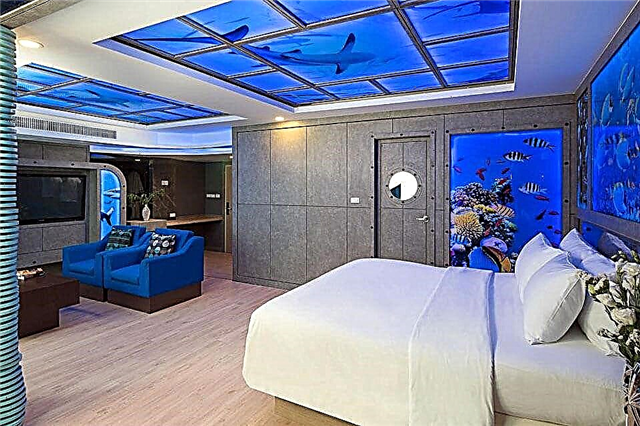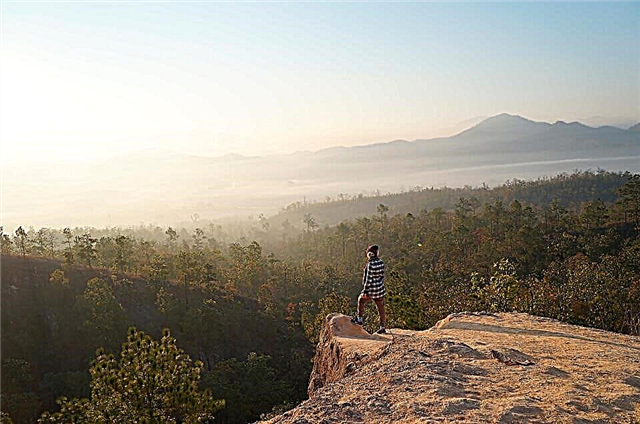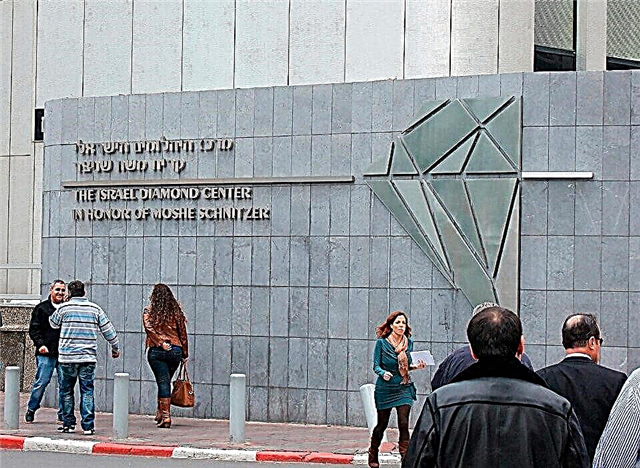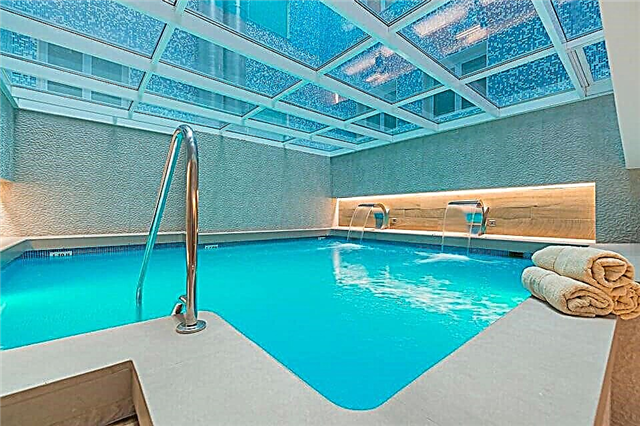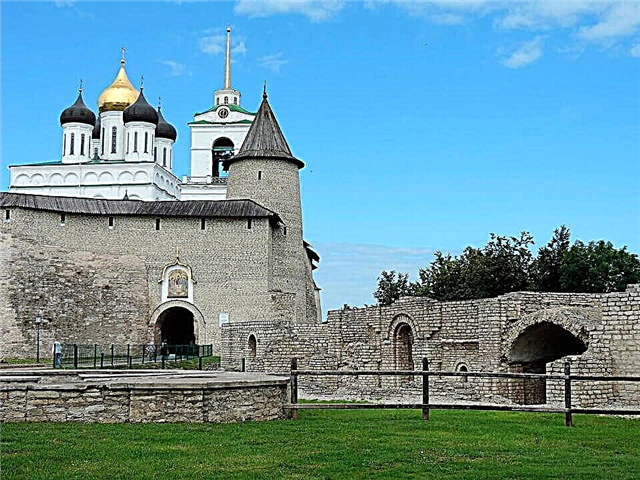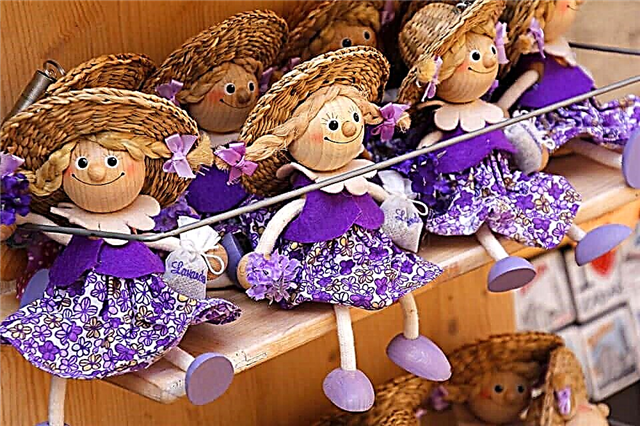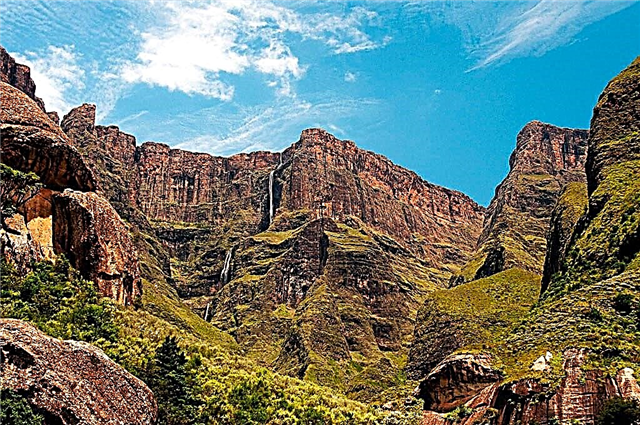The coastline with a length of 146 km and snow-capped mountain slopes, picturesque landscapes and futuristic buildings, ancient architectural monuments and modern entertainment centers. All this is about Sochi - the favorite Black Sea resort of millions of Russian citizens. The “Russian Riviera” gained worldwide fame by becoming the venue for the XXII Winter Olympic Games.
By the beginning of the grand event, 363 objects were renovated and built here. In February 2014, about 3,000 athletes from 88 countries arrived in the seaside town. Eminent athletes competed for the top awards in 15 disciplines. The best way to flip through the pages of the history of the legendary competition is to see with your own eyes the sights of the Sochi Olympic Park, which occupies more than 200 hectares of the Imeretinskaya lowland.
Medal Plaza

The central place of the park, the Medal Plaza, where the awarding ceremonies were held, reminds of the brilliant sports achievements today. The gigantic space is stunning in its dimensions - at the same time it can accommodate about 10,000 people. During the day, tourists walk here and fans of cycling tricks demonstrate their talents, and in the evening fans of variety concerts and the fantastic dance of singing fountains gather here.
In February 2015, Medalnaya Square hosted the presentation of the "Wall of the Champions of the Games" - a sculptural and decorative composition dedicated to the triumphant victories of athletes. The solemn event was attended by Dmitry Kozak, Vitaly Mutko and Russian sports stars. The snow-white object immediately gained popularity among tourists - at the height of the season, a line of people wishing to take a selfie lined up to it.
The new landmark is a stylized three-meter globe with meridians, parallels and continental silhouettes drawn on it. To the right and left are two symmetrical pyramids, designed to symbolize the Caucasus Mountains framing Sochi. The tetrahedral structure is adorned with 887 bronze, silver and gold plates, on which the names of the winners of the competition are indicated.
Singing fountain

The dominant feature not only of the Medal Plaza, but of the entire park is the Cup of the Olympic Flame. The prototype of the 50-meter stele, at the top of which an unquenchable torch blazed during the days of the competition, was the fabulous Firebird. The metal “head” of the mythological character is crowned with a red ridge, the outstretched “wings” embrace the pool with a diameter of 75 m. Inside the reservoir, a singing fountain of stunning beauty “dances”.
The mesmerizing action was made possible by 264 cannon nozzles located underground, which shoot jets flying up into the sky. By decreasing and increasing the ejection force, these powerful pumps create the illusion of water flowing up to 70 meters in height. The magnificent show is accompanied by world famous masterpieces of classical and modern music.
The fountain works both in the daytime and in the evening. The real magic begins when the sun disappears over the horizon. The gushing jets are illuminated by individual spotlights. The color filters installed on them change in accordance with the rhythm of the music tracks. To make the show even more colorful, fog and hundreds of twinkling stars appear on the surface of the pool.
Olympic Stadium Fischt"

"White head" - this is how the name of the "Fisht" stadium is translated from the Adyghe language. The grandiose structure is worthy of its name, received in honor of the 2,900-meter peak of the Caucasus Range. A translucent polycarbonate covering the upper part of the structure gives the impression of a mountain covered with snow and ice. This material is highly resistant to precipitation, wind and heat.
The construction of Fisht began in 2010. Three years later, a monumental six-story building appeared on the Black Sea coast. It is striking in its dimensions: the height of the stadium was 69 m, the dimensions of the arena - 105 x 68 m. According to open sources, the construction of the giant eased the state treasury by 23.5 billion rubles.
Fisht is known not only for the magnificent opening and closing ceremonies of the Olympics. In the summer of 2018, battles of the FIFA World Cup took place on a gigantic field covered with natural grass. You can learn about the glorious days of the competition, admire the exhibits of the sports museum and look into the premises inaccessible to ordinary spectators by visiting an exciting excursion around the stadium.
Ice Sports Palace "Iceberg"

Made of concrete, glass and steel LDS "Iceberg" resembles a block of ice plowing sea waves. The creators achieved the effect of incessant movement thanks to the smoothness of the lines and the alternation of blue and transparent stained-glass windows. Inside the phantasmagoric structure, which can simultaneously accommodate up to 12,000 spectators, two ice fields and a short track are freely located.
It's always cool at the Iceberg skating rink. The air temperature at a distance of 1 m from the ice surface varies from + 6 ° C to + 10 ° C. A different microclimate reigns in the stands. Stained-glass mirror glass units have excellent heat-insulating and sun-protection properties. In winter they keep warm, and in summer they save from the scorching rays. Therefore, at any time of the year, fans can enjoy the spectacular spectacle, without fear of melting from the heat or getting pneumonia.
Today "Iceberg" is not only sports tournaments, but also numerous entertainments. Under the roof of the palace, mass skating is organized and colorful ice shows are staged, in which famous Russian figure skaters take part. In addition, the stadium serves as a venue for ballroom dance competitions, musicals and concerts by popular performers.
Adler-Arena

For the single combat of world speed skating stars in 2012, the Adler Arena was erected - an oval structure 25 m high and with a capacity of 8,000 people. The building area is 51,151 m². Its main volume (20,300 m²) is occupied by the central hall with a giant ice rink, stands, VIP boxes and changing rooms for athletes. The rest of the territory is divided between technical rooms.
The appearance of the structure is also worthy of admiration. The basis for its creation was a unified concept of the park, which states that each building should carry a semantic load. The silhouette of the Adler Arena is associated with the image of an athlete striving for the finish line. The feeling of movement is enhanced by the metal "tape" encircling the facade, repeating the silhouette of a closed ice rink.
At the end of the Olympics, the refrigeration equipment was stopped, and the ice cover was replaced with an unpaved one. Skaters passed the baton to tennis players. In 2014, Adler-Arena hosted the International Federation Cup match between Argentinean and Russian teams. After the successful competition on the territory of the palace, the Academy of Tennis and Table Tennis was opened.
Sports Palace "Bolshoi"

Three years of painstaking work and 300 million dollars were spent on the construction of the pearl-white structure, whose cosmic forms are similar to the outlines of the Peking Opera. The Bolshoi DS, which opened in 2012, fully justifies its name. The height of the building is 49 m, the area is 96 155 m². The building can accommodate 12,000 people at the same time.
The pride of the Bolshoi is its ultra-modern technical equipment, which has no equal in Russia. The palace includes a ground 4-level and an underground 2-level part. The dome is equipped with a system of 38,000 multi-colored LED modules that transmit the image to the screen. The dimensions of this wonderful monitor are comparable to the total size of 12 hockey fields.
In 2014, the Sochi hockey club was created on the basis of the stadium, and a children's hockey school was opened 5 years later. In addition to ice battles for adults and young athletes, the Bolshoi hosts exhibitions, concerts, festivals, fairs and large-scale shows. This became possible thanks to the movable transforming stands, which allow you to change the area of the playing space.
Ice arena "Puck"

The five Olympic giants in Sochi are rounded off by a building whose streamlined shape simultaneously resembles a snow whirlwind and a sliding puck. The oval façade is decorated with blocks that range in color from white to blue. Even during the day, this decoration makes the stadium a real eye catcher. And with the onset of darkness, when 45 thousand LED lamps light up on the panels, its beauty “Puck” is able to compete with the southern sky.
Another amazing feature of the stadium is its mobility. "Washer" is a kind of constructor. The metal frame weighing 48,000 tons and a height of 22.8 m, occupying an area of 3.1 hectares, can be dismantled and transported to another location. Hundreds of rooms are hidden inside the unusual structure, the main of which are the ice arena and the 7,000-seat auditorium. Optimal row heights and huge screens allow you to comfortably monitor the progress of matches.
In 2013–2014 "Puck" served as a platform for hockey tournaments and ice sledge hockey competitions. After the fanfare of the Olympics died down, the stadium turned into an All-Russian sports and recreation base. The public all-season skating rink "Ldinka" is also open here.
Curling Center "Ice Cube"

Another famous Olympic heritage site is located next to the legendary stadiums. Built in 2013, the Ice Cube became the only Russian center dedicated to curling. In addition to the competition space, changing rooms, medical services, a restaurant complex, a gym and a choreographic hall are located inside the laconic blue-gray building.
The central core of the stadium is a curling area with four 45-meter lanes. Along the perimeter there are corridors for the movement of athletes, coaches and referees. The ice in this part of the field is covered with a special anti-slip material. The arena is surrounded by stands, government and VIP boxes, places for press services and commentators.
Unfortunately, the era of Sochi curling tournaments will soon come to an end. In the near future, the ice rink will be redesigned for international and all-Russian wrestling competitions. The place of curlers will be taken by sambists and judokas. A medical center, training halls and a hotel for athletes are planned to be built on the territory adjacent to the Ice Cube.
Sochi Circuit

A visit to the park is not only about getting to know Sochi's Olympic legacy. Those who are indifferent to sports will also find here activities to their liking. So, fans of car racing will appreciate the Sochi Autodrom. This 38.5 hectare facility is truly unique: it allows you to integrate a temporary section of the route into the city's transport system.
In October 2014, the 16th stage of the Formula 1 state of emergency started at Autodrom. The choice of the track was not accidental - the roadway is ideal for a race of this magnitude. On a three-layer asphalt concrete surface, the cars can accelerate to a speed of 330 km / h. The track, which is 5,848 meters long, is replete with challenging road conditions: 18 steep bends, negative inclines and a 650-meter long arched turn. The stands can accommodate up to 42,000 spectators.
In addition to watching Russian and world rallies, Avtodor offers tourists an excursion to the kingdom of racing. As part of an educational tour, guests of the resort will see the control center, the apartments for the teams and get acquainted with the life of the F-1 pilots. Those who wish can go up to the awards podium and take a photo.
Sochi Auto Sport Museum

Another meeting place for fans of iron horses is a museum located in the halls of the main stand of the Sochi Autodrom. The first exhibits of the collection - a "live" fireball and miniature models - visitors can admire right in front of the entrance to the building. Further, a world of luxury, bright colors and memories dear to the heart of a car enthusiast opens up. The collection consists of 79 famous cars of the XX and XXI centuries.
The pride of the museum is the faithful assistant of the legendary Mark Webber Jaguar R5B and the speed record holder Jaguar XJ220, erected on a pedestal. The champions are surrounded by worthy representatives of the Lamborghini, Ferrari, Mitsubishi, Dodge Viper, Masserati families. Separate showcases display racers' suits, helmets, cups, prizes, a Formula 1 chessboard, models of modern ships and old sailing ships.
The honorable place is occupied by true rarities - “car trendsetters” of the 50-70s of the last century: Chevrolet Impala, Chevrolet Corvette, Lincoln Continental, Buick Super, Kaiser Darrin and Dodge Custom. There is also the hero of the epic "Back to the Future" - the ever-living DeLorean DMC 12, as well as the stainless friend of James Bond Aston Martin DB9.
Park of Science and Art "Sirius"

Future Olympic medalists and winners of the highest awards in the field of culture, science and art are prepared by Sirius, an educational center created for the education and living of gifted children from different regions of the Russian Federation. On the territory of a huge complex, which includes classrooms, swimming pools, play spaces and comfortable rooms, young talents not only attend classes in in-depth study of school disciplines, but also participate in a variety of master classes, demonstration performances and sports tournaments.
In July 2018, a planetarium opened in Sirius, which immediately gained fame as one of the largest in the world. A spherical screen with an area of 157 m² is located under a silver dome with a diameter of 27 m, which blooms with purple lights at night. The giant monitor is equipped with laser projectors and a 10-channel sound system that allow you to create a realistic image and a full effect of being in the realm of stars and planets.
At the same time, 60 people can watch films about the origin and structure of the solar system, the study of the moon and the mysteries of the universe. The stories dedicated to the development of Buran, a spacecraft designed to transport cargo into orbit, are worthy of special praise. A full-size mock-up of the shuttle is also displayed at the Sirius Center.
Nikola Tesla Electric Museum

The Museum Center is located in an inconspicuous building next to the Sochi entertainment park, within the walls of which there are three diverse expositions. The first floor is occupied by a museum dedicated to the "father of electricity" Nikola Tesla. Instead of the usual exhibits, visitors will find an interactive show full of unusual and mesmerizing experiences.
The acquaintance with the museum begins with a screening of a short film about the work and inventions of the brilliant scientist. The viewing is followed by an incredible action, accompanied by numerous experiments. Both children and adults will be interested in learning how Tesla coils function, how to build a plasma Christmas tree, and whether 100 thousand volts can be passed through their own body.
The apogee of the program is the performance "Megavolt - Lord of Lightning". Dressed in metal chain mail, the "fighter with the elements" effortlessly catches the alternating current discharges generated by transformers. Lightning bolts are not optical illusions at all, the voltage reaches 1.5 million volts. The safety of spectators is ensured by a special protective circuit. To the delight of the audience, the fantastic show is accompanied by light and sound effects.
USSR Museum

Tourists, in whose hearts nostalgia for the good old days lives, will be interested in the exposition located on the second floor of the Museum Center.About 5,000 rarities will help you to travel back in time and see again the interiors, souvenirs, books, equipment, food, clothing and household items marked "Made in the USSR" that have sunk into oblivion.
An island of a country gone into oblivion greets visitors with soda machines. For men, whose childhood was in the 80s of the last century, a collection of miniature car models evokes tender feelings. An impromptu store is also popular among visitors, on the counter of which canned food, bottles of Stolichnaya, packs of Indian tea and Java cigarettes are lined up.
There was a place in the Museum of the USSR for the dream of every Soviet person - polished walls, china sets, tape recorders, Zenit cameras and motor scooters. Also presented here is an exclusive: Soviet 3D TV and a microwave oven. The artifacts are not hidden behind glass - they can be picked up, and even ride bicycles and cars with pedals is allowed.
Mechanical Museum of Leonardo da Vinci

It is difficult to imagine a field of science and art to which Leonardo da Vinci, a scientist, engineer, architect, writer, artist and musician, would not have contributed. The life of the creator was full of secrets and hoaxes, and unique achievements in many ways outstripped the Renaissance. Until now, the inventions and paintings of the genius haunt the great minds of the whole world, hundreds of museums are devoted to his works. One of them is located on the third floor of the Museum Center.
The purpose of the exhibition is not only to acquaint visitors with the inventions of the phenomenal Master, but also to show them in action in a playful way. All instances are functional models created from da Vinci's drawings. Here you can watch the work of a perpetual motion machine, sit in a paraglider, lift a heavy load with your own hands, or try to break a wooden bridge assembled without a single nail.
The 24-meter crossbow, trebuchet, catapult, hygrometer, auto hammer and candle clock are of great interest. Each exhibit is provided with a stand with a detailed description. Along with mechanical devices, the museum collection also contains reproductions of famous paintings by the painter, such as "Mona Lisa", "Lady with an Ermine", "Portrait of a Musician", "Madonna Litta".
Roller Restaurant

The Black Sea resort does not experience a shortage of catering establishments. The competition is huge. The fastidious tourist can no longer be surprised by delicious dishes, people want not only bread, but also spectacles. With this in mind, the Roller restaurant offers its guests an interesting service system. Ordered food rushes to visitors along roller tracks - metal spiral structures that start in the kitchen and end at round tables.
There is no need to wait for the arrival of the waiter. To place an order, there are touch monitors installed on each table. When the choice is made, it is the turn of the chefs. Cooked food is packed in special containers with transparent lids. Then the dishes descend from a 12-meter height, laying sharp turns along the road and drawing dead loops.
The local menu is an assortment of Russian and overseas dishes. The chef is especially good at burgers, chicken strips, tagliolini carbonara, grilled asparagus, okroshka on kvass and stewed buckwheat flavored with mushrooms. Little guests are not forgotten in the restaurant. Young gourmets are offered to taste a bread pan, colorful dumplings and macaroons with meatballs. And, of course, ice cream. In Roller, it's just great.
Olympic Village

By 2014, three- and six-story buildings appeared on the Imeretinskaya lowland, where previously only tall grass was growing. The settlement with an area of 164,000 m² was lovingly called by the designers "The Manor". Inside 47 buildings there were modern comfortable apartments for participants in the Olympic Games. In addition to residential buildings, cafes, clubs and a medical center were opened here. To provide the new facilities with uninterrupted power supply, a power plant was built near the settlement.
After the Olympics, the place of residence of athletes turned into a fashionable Imereti resort microdistrict with wide alleys, an embankment, beaches, restaurants, shops and entertainment centers. Here you can buy real estate, rent apartments or relax in one of the hotel complexes.
There is a second Olympic village in Sochi - Gornaya, built for skiers and biathletes. The settlement is located in the Rosa Khutor resort, where stunning views of the Psekhako and Aibga ridges open from an altitude of 1,170 m above sea level. Thanks to the fresh air, natural beauty and the nearby sports facilities, the former houses of the participants of the games, after the competition, were converted into comfortable hotels, today are not empty both in winter and in summer.
Sochi Park Theme Park

Russian Disneyland is a worthy name for Sochi Park, which is located next to the Bogatyr Hotel. A sea of positive emotions and joy will be presented by 23 attractions - from carousels for babies to trembling designs. The most extreme ones are equipped with safety sensors. Also, the entertainment center is famous for its petting zoo, play and development areas, theatrical performances and performances of circus artists.
Visitors will find five amazing worlds filled with heroes of fairy tales familiar from childhood. The Whale-Fish, Swan-Geese, The Little Humpbacked Horse, the Flying Ship and the Serpent Gorynych settled here, through whose lair at a speed of 100 km / h roller coaster trailers rush. Emotions in the park are in full swing: from the horror of free fall from a 65-meter height ("Firebird") to unrestrained laughter (water battles of the "Buyan" attraction).
A visit to the dolphinarium will be a pleasant bonus. A friendly team of three bottlenose dolphins and a fur seal pleases their guests with an exciting show lasting 40 minutes. The program includes jumping over the bar, drawing pictures, playing with a ball, incendiary somersaults, skating of animal trainers, graceful dances and solo performances. For an additional fee, you can take a picture with a participant in the show or swim in the company of a dolphin.


